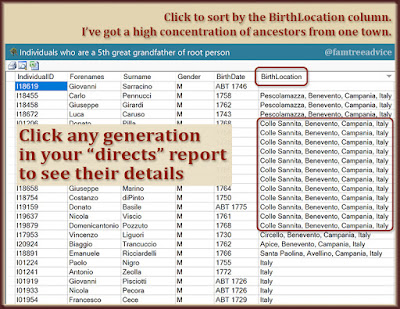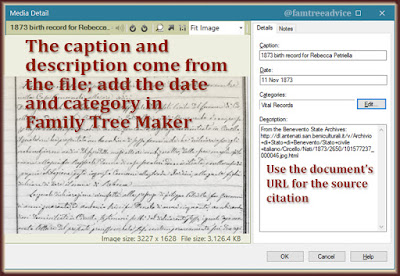Revisiting a clean-up project instantly added dozens of relatives to my family tree.
In July I recommended using Family Tree Analyzer to find the unsourced facts in your family tree. For the steps, see Catch and Fix Your Missing Source Citations.
My report seemed to have a lot of false positives. Many facts in the list actually had proper sources in my family tree. Discouraged, I tried another method. I ran the Undocumented Facts report in Family Tree Maker. I exported the report as a massive Excel file. It's huge because I have 25,000 people in my family tree, and I don't add a source for a person's sex. So everyone made it into the report!
I spent time deleting lots of lines from that spreadsheet. Then I decided to revisit the report in Family Tree Analyzer. This time I excluded another fact type (Parental Info) before exporting it to Excel.
 |
| With a bit more fine-tuning, the report turned out great. |
I realized I could cut out all the dates that I left unsourced on purpose. When I don't know someone's birth date, I give them an estimate. In your family tree software, you can type "About" or "Abt" when you're entering an approximate date.
If they are a parent, I make them 25 years older than their oldest child. If I know their spouse's birth year, I estimate they were born about the same year.
Since there can't be a source for my "About" dates, I don't need them in this report. I sorted the report by the Date of Birth column and removed every line where the date begins with "ABT" (for about). Now I'm down to about 114 lines in the spreadsheet. The Undocumented Facts report in Family Tree Maker produced a 45,000-line spreadsheet!
Diving into the New Unsourced Facts Report
The first few lines are for my young cousin-in-law. I have no sources for him, but later I'll see what I can find online.
I'd prefer to work on my 19th century Italian relatives first. The first one in the list is Lorenzo Capozza. In my family tree I see he was born in 1828 in my great grandmother's town of Pescolamazza. He married my 3rd great aunt, Nicolina Caruso, on 19 Apr 1856 in that town.
I must have been rushing along when I found this marriage fact. I didn't save the marriage record to my tree. I didn't chase down Lorenzo's birth date or parents. And I didn't add my sources. Bad genealogist!
Lorenzo was 28 years old when he married my aunt in 1856, so he should have been born in 1828. The marriage record says he was born in the same town, but something's wrong. I have all the town's available vital records on my computer. He isn't in the birth records for 1826 through 1829. I can keep searching each year's birth index, or I can go to the detailed records in the 1856 marriage documents.
Before I do that, the marriage record says Lorenzo's parents are Pietro Capozza and Maria Emanuele Pennuccia. I looked for them in my family tree.
One Man Makes His Mark
They're in there, along with their son Antonio, 5 grandchildren, 5 great grandchildren, and at least 12 2nd great grandchildren! I'd already pieced together a huge family for them from the vital records collection. But I never found Lorenzo.
 |
| Feel free to borrow this image. |
But that's only part of the story. All the people related to Pietro Capozza and Maria Emanuele Pennuccia in my tree are UNRELATED to me. I've given them all my "No Relationship Established" graphic as a profile picture. (See How to Handle the Unrelated People in Your Family Tree.)
The moment I make Lorenzo the son of Pietro and Maria, all those people will be my relatives. The relationship is through Lorenzo's wife, my 3rd great aunt.
Why did I put this enormous unrelated family in my tree, you ask? It was an out-of-control case of mistaken identity! When my great grandparents married in 1906, a couple from her hometown were the witnesses. The male witness was Nicola Capozza—same last name as our Lorenzo. But he was from a different branch of the family.
I realized too late that all those descendants of Pietro and Maria were an unrelated family.
Until now.
With Lorenzo attached to his parents, all those people are now relatives. I have to remove the "No Relationship Established" graphic from each one. How tedious.
But I have a method I'd like to share with you.
 |
| This trick simplifies an error-prone task. |
Here's how I handle a big change like that. I have that graphic attached to a large number of people, so finding all the right people in a list wouldn't be easy. What I do is:
- Click everyone in the family who needs the graphic removed, one at a time.
- Change their last name to begin with a 1. Capozza becomes 1Capozza. That makes it easy to find the right people in the list of who's attached to that graphic.
- Go to one person with that graphic and click to detach it.
- This brings up a list of each person attached to the graphic. I can select everyone whose name begins with 1.
- Once I remove the image, I rename everyone in my family tree whose name begins with a 1.
That may not seem like a big deal to you, but it's very helpful. I used to struggle with removing that graphic from the right person. A lot of the townspeople have identical names! I use a 1 so it's at the top of my index of all people—easy to find.
Now comes a much bigger challenge. All those new relatives need their vital records and sources!

















